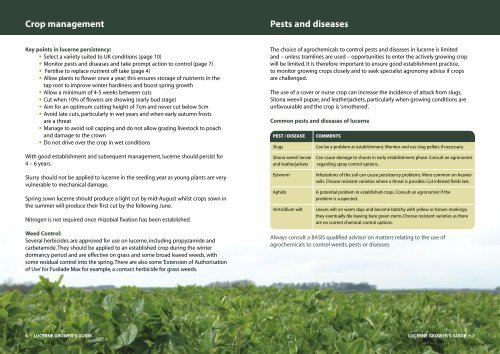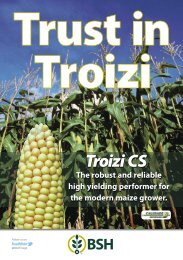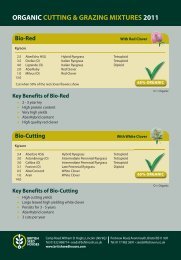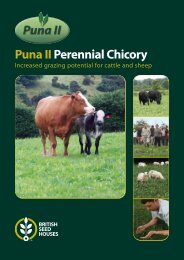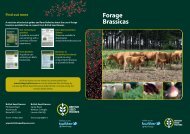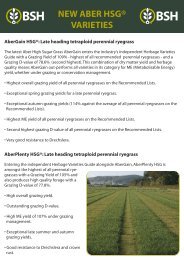Lucerne Growers Guide - British Seed Houses
Lucerne Growers Guide - British Seed Houses
Lucerne Growers Guide - British Seed Houses
- No tags were found...
You also want an ePaper? Increase the reach of your titles
YUMPU automatically turns print PDFs into web optimized ePapers that Google loves.
Crop managementPests and diseasesKey points in lucerne persistency:• Select a variety suited to UK conditions (page 10)• Monitor pests and diseases and take prompt action to control (page 7)• Fertilise to replace nutrient off take (page 4)• Allow plants to flower once a year; this ensures storage of nutrients in thetap root to improve winter hardiness and boost spring growth• Allow a minimum of 4-5 weeks between cuts• Cut when 10% of flowers are showing (early bud stage)• Aim for an optimum cutting height of 7cm and never cut below 5cm• Avoid late cuts, particularly in wet years and when early autumn frostsare a threat• Manage to avoid soil capping and do not allow grazing livestock to poachand damage to the crown• Do not drive over the crop in wet conditionsWith good establishment and subsequent management, lucerne should persist for4 – 6 years.The choice of agrochemicals to control pests and diseases in lucerne is limitedand – unless tramlines are used – opportunities to enter the actively growing cropwill be limited. It is therefore important to ensure good establishment practice,to monitor growing crops closely and to seek specialist agronomy advice if cropsare challenged.The use of a cover or nurse crop can increase the incidence of attack from slugs,Sitona weevil pupae, and leatherjackets, particularly when growing conditions areunfavourable and the crop is ‘smothered’.Common pests and diseases of lucernePEST / DISEASESlugsSitona weevil larvaeand leatherjacketsCOMMENTSCan be a problem at establishment. Monitor and use slug pellets if necessary.Can cause damage to shoots in early establishment phase. Consult an agronomistregarding spray control options.Slurry should not be applied to lucerne in the seeding year as young plants are veryvulnerable to mechanical damage.Spring sown lucerne should produce a light cut by mid-August whilst crops sown inthe summer will produce their first cut by the following June.Nitrogen is not required once rhizobial fixation has been established.EelwormAphidsVerticillium wiltInfestations of the soil can cause persistency problems. More common on heaviersoils. Choose resistant varieties where a threat is possible. Cut infested fields last.A potential problem in established crops. Consult an agronomist if theproblem is suspected.Leaves wilt on warm days and become blotchy with yellow or brown markings;they eventually die leaving bare green stems.Choose resistant varieties as thereare no current chemical control options.Weed Control:Several herbicides are approved for use on lucerne, including propyzamide andcarbetamide. They should be applied to an established crop during the winterdormancy period and are effective on grass and some broad leaved weeds, withsome residual control into the spring. There are also some ‘Extension of Authorisationof Use’ for Fusilade Max for example, a contact herbicide for grass weeds.Always consult a BASIS qualified advisor on matters relating to the use ofagrochemicals to control weeds, pests or diseases.6 • LUCERNE GROWER’S GUIDELUCERNE GROWER’S GUIDE • 7


